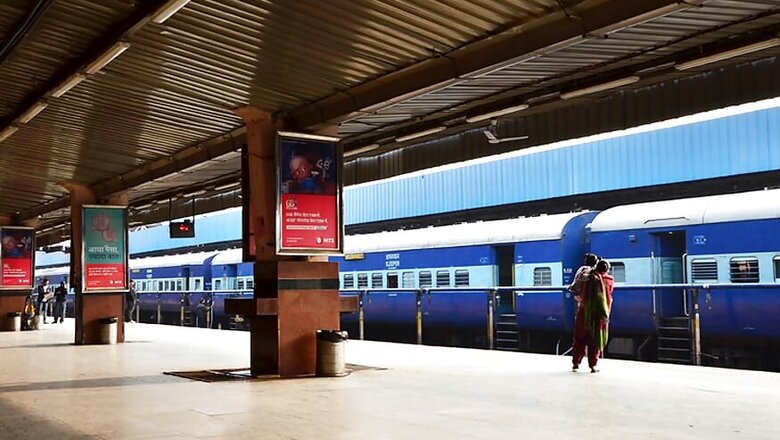
views
New Delhi: Stung by incessant criticism over its flexi-fare scheme in premium trains, the Indian Railways is looking to effectively lower fares in Rajdhanis, Shatabdis and Durontos by tweaking this fare structure. The tweaking, if approved, will result in lesser number of seats on the highest fare bucket, effectively allowing far more number of passengers to purchase tickets at the base fare than at present. So one needn’t start checking travel portals for flight tickets just yet for the summer holidays – perhaps the Rajdhani journey will be more affordable yet.
According to the proposal, almost half the seats available on these premium trains could actually come at the base fare, against just 10% now. This proposal comes after fares on select Shatabdi trains have already been slashed.
The railways has seen stringent criticism from several quarters for introducing flexi fares in premium trains despite limited impact of such a fare structure and its success in generating additional revenue.
Flexi fare impacts just about 0.35% of the total passengers travelling on the railways’ network on any given day and it managed to generate Rs 800 crore in additional revenue in the first full year of its implementation till August 31, 2017.
Besides, cost of carrying passengers has been increasing each year with no increase in passenger fares. There has been no fare hike in almost eight years. It is also well known that freight earnings continue to subsidise passenger earnings for the railways and in the absence of political will to raise passenger fares, flex-fares were the next best option to generate additional revenue. But instead of getting bouquets for thinking up this scheme to boost revenues with minimum pain, one of the world’s largest transporters is struggling to please its critics with tweaks.
It has already modified the flexi fare system once earlier. By offering 10% rebate in basic fare on vacant berths/seats after preparation of first chart in these trains; discounted fare is also being offered for the passengers in several Shatabdi trains with low occupancy. Besides; provision of tatkal quota has been reduced in flexi fare trains from maximum 30% to 10% of the total berths availability.
The railways started flexi-fare system in September 2016, egged on by the prospect of earning more revenue by smart pricing. Under this system, the base fare increases by 10% with every 10% of berths sold subject to maximum ceiling limit of 1.5 times in classes Second AC, Sleeper, Second Sitting (Reserved), AC Chair Car and 1.4 times in 3rd AC class. No change was made in the fares for 1st AC and Executive Class.
Senior railway ministry officials say the proposal to tweak the present flexi-fare scheme has come about after repeated complaints by MPs and others about rising passenger fares of premium trains due to this fare fixing strategy.
According to data provided by the Ministry of Railways in Parliament this year, flexi-fare has resulted in a drop in occupancy of these trains. The occupancy of rajdhanis was down by 2.51 percentage points in November 2017 against the same month in 2016. For Shatabdis the decline is 2.74 percentage points and for Durontos, 3.22 percentage points. Never mind that occupancy is seasonal and there is no way of knowing how much of the decline in occupancy was purely on account of raised fares.
Anyway, on the unjustified brickbats the railways seems to be ducking, even the Comptroller and Auditor General of India (CAG) has urged it to have a relook at its passenger fares in order to reduce its losses in the segment.
In its latest report, CAG has said that the railways ministry needs to revisit the passenger and other coaching tariffs so as to recover the cost of operations in a phased manner and reduce its losses in core activities. “The fixation of passenger fare and freight charges should be based on the cost involved so that it brings both rationality and flexibility in pricing considering the financial health of railways and the current market scenario.”
The railways cross-subsidises passenger fares through freight charges, which not only hurts overall revenues but also drives away freight to the road sector. The loss on account of passenger fares (railways’ social obligation cost) for 2015-16 stood at Rs 36,286.33 crore. In this scenario, it should extend the flexi fare scheme to other trains, instead of being forced to rework it even on existing trains.
There is a popular misconception that this scheme is like the surge pricing in airlines. This is not true. The railways does not increase fares based on how many people are trying to book a ticket, it does not increase fares in most cases during festivals and seasonal rush, there is a ceiling up to which it will raise fares even on the premium trains where flexi system is being implemented.
Besides, the railways offers multiple fare and time options for passengers wary of flexi fares, in other trains. These factors make the railways distinct from airlines, which have limited connectivity even today and do not offer multiple fare options on a given day. The flexi fare system should get all the support of our MPs and the travelling public, if they want to see railways’ finances improve.















Comments
0 comment